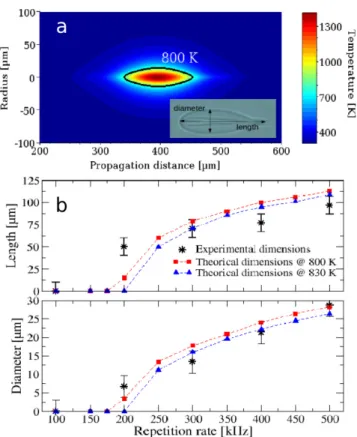HAL Id: hal-01183006
https://hal.archives-ouvertes.fr/hal-01183006
Submitted on 5 Aug 2015HAL is a multi-disciplinary open access
archive for the deposit and dissemination of sci-entific research documents, whether they are pub-lished or not. The documents may come from teaching and research institutions in France or abroad, or from public or private research centers.
L’archive ouverte pluridisciplinaire HAL, est destinée au dépôt et à la diffusion de documents scientifiques de niveau recherche, publiés ou non, émanant des établissements d’enseignement et de recherche français ou étrangers, des laboratoires publics ou privés.
Material Processing by fs Laser Pulse Trains:
Experiments vs. Simulations
O Dematteo Caulier, B Chimier, Stefan Skupin, A Bourgeade, K Mishchik, C.
Javaux Léger, R Kling, C Hönninger, J Lopez, V Tikhonchuk, et al.
To cite this version:
O Dematteo Caulier, B Chimier, Stefan Skupin, A Bourgeade, K Mishchik, et al.. Material Processing by fs Laser Pulse Trains: Experiments vs. Simulations. 24th ANNUAL INTERNATIONAL LASER PHYSICS WORKSHOP, Aug 2015, Shanghai, China. �hal-01183006�
Material Processing by fs Laser Pulse Trains: Experiments
vs. Simulations
O Dematteo Caulier1, B Chimier1, S Skupin1, A Bourgeade1, K Mishchik1, C Javaux Léger2, R Kling2, C Hönninger3, J Lopez1, V Tikhonchuk1, and G Duchateau1
1University of Bordeaux, CEA, CNRS, CELIA (Centre Lasers Intenses et Applications) UMR 5107, Talence,
France
2ALPHANOV, rue François Mitterand, Talence, France
3Amplitude Systemes, 11 avenue de Canteranne, Cité de la Photonique, Pessac, France
Contact Email: dematteo@celia.u-bordeaux1.fr
Figure 1: (a) Theoretically predicted thermal map and ex-perimental structure induced by a train of 500 laser pulses at 500 kHz repetition rate (RR) and with an incident en-ergy of 1.3 µJ per pulse. (b) Experimental (stars) and theoretical (squares and triangles) dimensions as a func-tion of the RR. The laser pulses were propagating from left to right
The use of femtosecond (fs) trains of pulse is now well established as an efficient technique to modify dielectric materials. Through numerous ex-perimental parameters, it is possible to adjust the amount of deposited energy into the material with a great accuracy.
When an intense fs laser pulse is focused in-side a dielectric material, here soda-lime glass, elec-trons get promoted from the valence band (VB) to the conduction band (CB) by photo-ionization pro-cesses. After the fs pulse interaction, electrons in the CB transfer their energy to the lattice through collisional processes, and heat diffusion towards the surrounding cold matter of the focal point sets in. Due to the low heat diffusion coefficient (a few mi-croseconds for micron-size volume), and by using a few hundreds kilohertz repetition rate (RR), one can achieve pulse-to-pulse accumulation of temper-ature. For sufficiently large number of pulses, it is possible to exceed the annealing temperature, and the dielectric material gets modified permanently.
Our approach to simulate this phenomenon is based on the separation of the different timescales of the key physical processes. To this end, the laser pulse propagation is simulated by a paraxial For-ward Maxwell code taking into account key nonlin-ear effects [1], in order to compute the single pulse energy deposition in the material. Thermal diffu-sion is taken into account by the heat equation [2],
where we use the (repeated) single pulse energy deposition as heat source. Finally, reaching the annealing temperature is used as a threshold to get the dimensions of the permanent modification of the matter.
Simulations and experiments were performed in soda-lime glass for a train of 300 fs pulses with an incident energy of 1.3 µJ per pulse. The laser beam, with a wavelength centered around 1030 nm, was focused into the glass bulk by a 10× objective. The theoretically predicted dimensions of the glass transition temperature zone presented in Fig. 1(a) are confronted with the dimensions of the experimental modifications of the glass [c.f. Fig. 1(b)]. We note a threshold-like behavior for the onset of measurable modifications between 100 and 200 kHz, in the experiments as well as in the simulation results. The experimental dimensions are well reproduced by our model, despite a slight deviation in the predicted
length for 200 and 300 kHz. We attribute this discrepancy to changes in the propagation dynamics due to successive material modification [3] which is not (yet) taken account in this work.
References
[1] L Bergé, S Skupin, R Nuter, J Kasparian, and J-P Wolf, Rep. Prog. Phys. 70, 1633 (2007)
[2] S M Eaton, H Zhang, P R Herman, F Yoshino, L Shah, J Bovatsek, and A Y Arai, Opt. Express 13, 4708 (2005)
